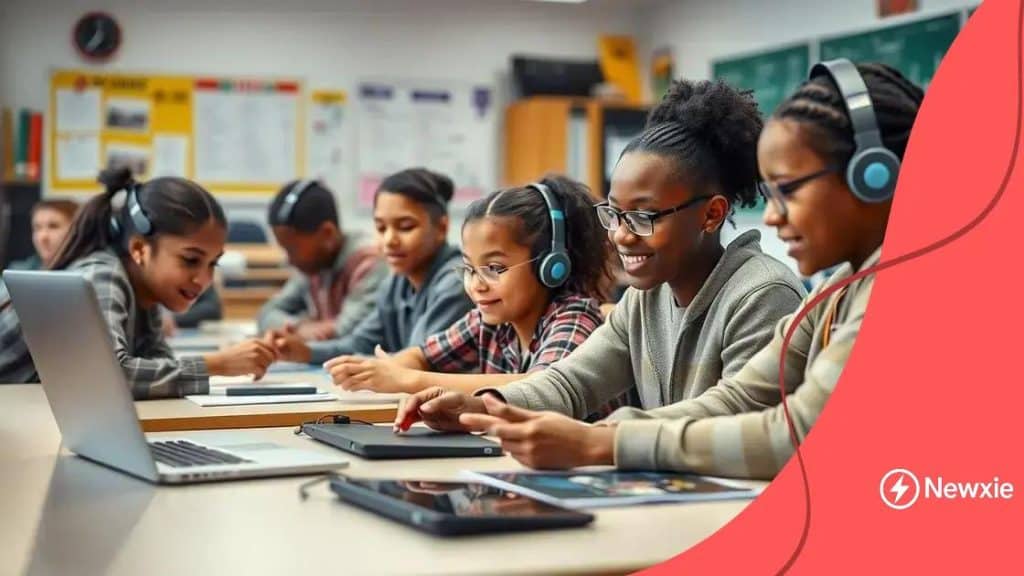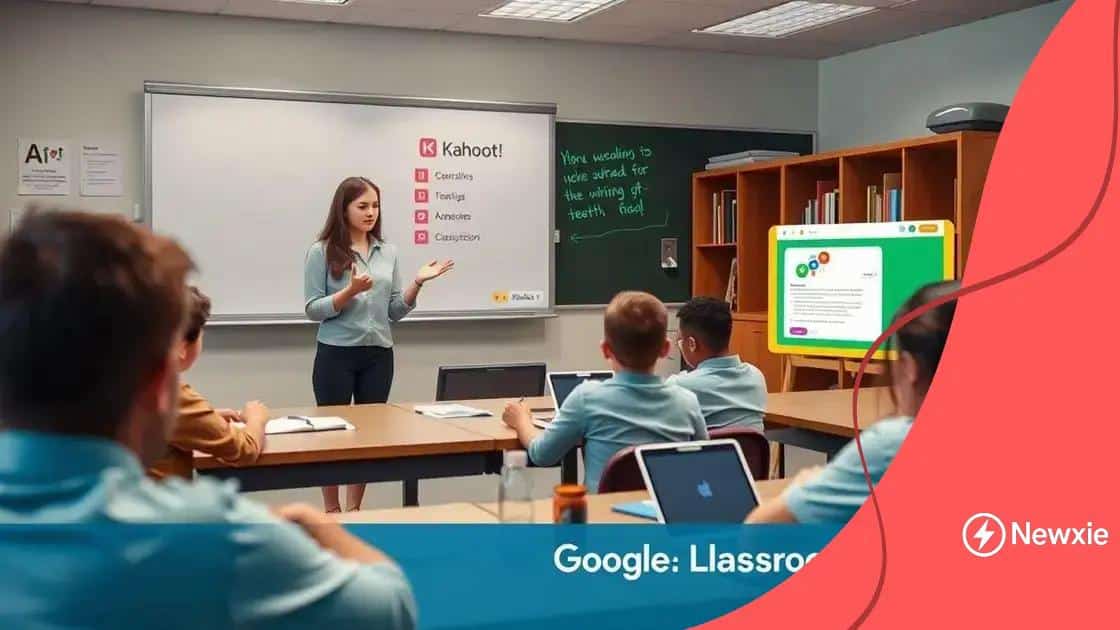AI tools for classroom teaching: enhancing learning experiences

Anúncios
AI tools for classroom teaching enhance learning by personalizing educational experiences, increasing student engagement, and providing valuable insights through data analytics.
AI tools for classroom teaching are changing how educators approach their lessons and engage students. Have you ever wondered how technology could enhance learning experiences? In this article, we’ll dive into the innovative ways AI can transform your classroom.
Anúncios
Understanding AI tools for education
Understanding AI tools for education is essential for today’s educators. These tools offer groundbreaking solutions that help teachers and students alike.
By leveraging technology, educators can create more engaging and efficient learning environments. Let’s explore the various aspects of AI tools that are transforming educational practices.
What are AI tools?
AI tools for education refer to software and applications that utilize artificial intelligence to enhance learning experiences. They can assist in a variety of ways, making education more personalized and effective.
Anúncios
Benefits of AI tools in education
- Personalized learning: AI can adapt lessons to meet individual student needs.
- Efficiency: It helps automate administrative tasks, giving teachers more time to focus on teaching.
- Engagement: Interactive AI tools can make learning more fun and relatable for students.
Furthermore, AI tools can analyze student performance data to provide insights that help educators improve their teaching strategies. By understanding these analytics, teachers can identify areas where students need extra help.
Moreover, AI tools can enhance collaboration among students. By fostering group interactions through intelligent systems, students learn to work together effectively.
Popular AI tools used in classrooms
Some widely used AI tools in education include:
- Kahoot! for interactive quizzes that make learning competitive and fun.
- Duolingo for language learning with adaptive lessons.
- Google Classroom for managing assignments and communication.
In conclusion, understanding how AI tools function in educational settings can empower teachers to create more dynamic and effective learning experiences. Embracing these tools prepares students for a future where technology remains integral to their lives.
Benefits of AI in classroom settings
The benefits of AI in classroom settings are significant and can transform how students learn and teachers teach. By incorporating AI tools, educators can enhance the overall learning experience.
One major advantage is the ability to provide personalized learning paths for students. AI can analyze each student’s strengths and weaknesses, allowing educators to tailor lessons accordingly. This customization helps students to learn at their own pace.
Increased engagement
Another benefit is improved student engagement. With interactive AI tools, lessons become more dynamic and fun. Students are more likely to participate in activities that involve technology, making learning less of a chore and more of an exploration.
- Gamification: Many AI tools use games to teach concepts, which captivates students.
- Interactive platforms: Tools that allow for real-time feedback keep students involved.
- Collaborative learning: Students can work together on projects using AI, promoting teamwork.
Additionally, AI helps educators manage their time more effectively. With automation of tasks such as grading and scheduling, teachers can spend more time on instruction and less on paperwork.
AI also supports data-driven decision-making in the classroom. By analyzing performance data, educators can identify trends and make informed adjustments to their teaching strategies. This proactive approach ensures that every student receives the support they need.
Accessibility improvements
Furthermore, AI tools can bridge gaps for students with diverse learning needs. They can provide speech-to-text services, language translation, and resources tailored for different learning abilities. Such features ensure that no student is left behind, enhancing overall classroom inclusivity.
The integration of AI in education fosters a positive learning environment where every student can thrive. Teachers benefit from having more tools at their disposal, and students gain a richer, more personalized educational experience.
Popular AI tools for teachers

Many popular AI tools for teachers have emerged, helping educators manage classrooms more effectively and enhance learning. These tools are designed to simplify tasks and provide engaging experiences for students.
One notable tool is Kahoot!, which allows teachers to create interactive quizzes. This platform engages students through gamified learning, making concepts easier to grasp. Teachers can see real-time results, enabling them to adjust instruction on the fly.
Artificial Intelligence in Learning Apps
Duolingo is another fantastic option for language learning. It uses AI to adapt lessons to each learner’s capability, ensuring they progress at their own pace. This adaptability helps students feel more comfortable and succeed in learning new languages.
- Quizlet: This tool helps students create flashcards and study sets, making memorization easier.
- Edmodo: A platform for communication and collaboration that connects students and teachers.
- Google Classroom: It streamlines assignment distribution and grading while promoting organization for both teachers and students.
Moreover, tools like Classcraft incorporate elements of gaming to motivate students. By turning learning into an engaging quest, students are more likely to participate actively. This not only increases enjoyment but also knowledge retention.
As educators explore these tools, they discover valuable resources that cater to diverse classroom needs. Each tool brings unique advantages, allowing teachers to customize their approaches and foster student engagement.
Analytics and Performance Tracking
AI tools also provide important analytics. Nearpod, for instance, offers real-time feedback on student performance during lessons. This immediate information helps teachers identify students who may need extra support, allowing for timely interventions.
Utilizing these popular AI tools helps educators create an interactive, personalized, and effective learning environment. As technology evolves, these tools will continue to play a crucial role in modern education.
Implementing AI effectively
Implementing AI effectively in the classroom requires thoughtful planning and execution. Teachers must consider several factors to ensure that AI tools enhance learning experiences.
First, it is crucial to identify the specific needs of the classroom. Each class has its unique dynamics and challenges. Understanding what issues AI can address is the first step toward a successful implementation. This targeted approach allows educators to select tools that align with their teaching goals.
Steps for Successful AI Implementation
Once needs are identified, teachers should choose appropriate AI tools. For instance, tools that focus on personalized learning will benefit students who need extra help. After selecting the tools, training for both teachers and students is vital. Familiarity with the technology ensures that everyone can use the tools effectively.
- Start small: Begin with one or two tools to avoid overwhelming students.
- Provide training: Invest time in training sessions to ensure confidence in using AI tools.
- Set clear goals: Define what success looks like, so everyone is on the same page.
Moreover, monitoring the impact of AI tools is essential. Collect data on student performance and engagement to assess whether the tools are effective. This data can indicate what’s working and what needs adjustment.
Fostering a Positive Environment
Creating a classroom environment that embraces technology is equally important. Encourage students to share their experiences with AI tools, promoting a culture of openness and collaboration. When students feel comfortable discussing their learning processes, they are more likely to engage with the tools provided.
Additionally, staying updated with the latest AI developments is crucial. New tools and updates can enhance functionality, providing even more benefits. Join educator networks or attend workshops to learn about new possibilities.
In conclusion, implementing AI effectively involves careful selection of tools, training, and a supportive environment that encourages feedback and improves learning outcomes.
Future trends in AI education
Future trends in AI education promise to reshape how students learn and how teachers instruct. As technology evolves, the integration of AI in classrooms will become more sophisticated and widespread.
One significant trend is the increased use of personalized learning systems. These systems analyze student data to tailor educational experiences. For example, AI can identify when a student struggles with a topic and adjust lessons to provide more practice and support.
Integration of Virtual Reality
Another exciting trend is the incorporation of augmented reality (AR) and virtual reality (VR) into lessons. These technologies create immersive learning environments that can engage students in unique ways. Imagine students exploring ancient civilizations through virtual field trips, making history come alive.
- Enhanced engagement: Virtual environments captivate students’ attention.
- Real-world applications: Students can practice real-life scenarios in a safe space.
- Collaborative learning: VR allows for cooperative projects among students.
Moreover, the emergence of AI-driven tutoring systems will be vital. These systems provide assistance tailored to individual learning styles. They offer on-demand help, ensuring that students receive support exactly when they need it.
AI Ethics in Education
As AI becomes more influential, discussions around ethics in education will gain importance. Schools will need to address questions about data privacy and the impact of AI on job opportunities. Educators will have to prepare students for an AI-driven workforce, helping them understand the ethical implications of technology.
Along with ethical considerations, integrating AI into curricula will become essential. Students will need to learn how to use AI tools effectively and responsibly. This knowledge will prepare them for the changing landscape of the job market.
The incorporation of AI education will create a generation of learners who are not only technologically savvy but also ethically aware. The future is bright, with endless possibilities for enhancing education through AI.
FAQ – Questions About AI Tools in Education
How can AI tools enhance classroom learning?
AI tools provide personalized learning experiences, adapt lessons to student needs, and increase engagement with interactive content.
What are some examples of popular AI tools for teachers?
Popular AI tools include Kahoot! for quizzes, Duolingo for language learning, and Google Classroom for managing assignments.
How does AI improve student engagement in lessons?
AI enhances engagement by offering dynamic, interactive learning experiences that motivate students to participate actively.
What ethical considerations should educators keep in mind with AI?
Educators should consider data privacy, the impact of AI on job markets, and how to prepare students for ethical technology use.
SEE MORE CONTENT




